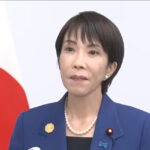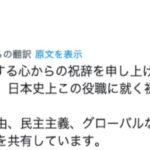Sanae Takaichi’s New Cabinet Surges Past 60% Approval: Proactive Fiscal Policy and Tax Cuts to Revive Japan’s Economy
The Birth of the Takaichi Cabinet — A Historic Moment for Japan
Japan has entered a new political era with the formation of the Sanae Takaichi Cabinet, marking the country’s first female-led administration in years. Within days of taking office, the new government achieved an impressive approval rating exceeding 60%, signaling strong public support for its policy agenda. This extraordinary figure reflects a renewed sense of optimism among citizens who have long sought decisive leadership to revitalize Japan’s stagnant economy.
Prime Minister Takaichi’s rise represents more than a change in leadership; it symbolizes a transformation in Japan’s political and economic philosophy. Her campaign focused on two key promises: proactive fiscal policy and strategic tax reduction. These commitments stand in stark contrast to the fiscal conservatism that has characterized previous administrations, offering a new path toward sustainable growth and national renewal.
At her inaugural press conference, Takaichi emphasized her determination to “restore Japan’s economic vitality through active government spending and fair income distribution.” This statement was met with strong approval from both economists advocating Keynesian-style stimulus and ordinary citizens weary of deflationary stagnation. Her pledge to challenge the long-standing dominance of the Ministry of Finance (MOF) — an institution often seen as resistant to fiscal flexibility — has positioned her as a reformist willing to confront entrenched power structures.
Political analysts note that her early popularity stems from a rare combination of credibility and conviction. Takaichi, a long-time member of the ruling Liberal Democratic Party (LDP), has cultivated a reputation as a principled conservative who values both economic strength and national sovereignty. By linking fiscal expansion to Japan’s broader geopolitical goals — including technological independence and supply chain security — she has reframed economic policy as a matter of strategic resilience rather than mere budgetary arithmetic.
Public sentiment surveys conducted by major Japanese media outlets show particularly high approval among working-class families and small business owners — demographics that stand to benefit most from her tax cut proposals. The message is clear: Takaichi’s government is not only about politics but about restoring confidence in Japan’s future. For many, her leadership signals the dawn of a new era of growth, empowerment, and economic recovery.
As Japan moves into this uncharted chapter, both domestic and international observers are watching closely. Whether Takaichi can translate popular enthusiasm into lasting reform remains to be seen, but one thing is certain — her administration has reignited hope for a stronger, more self-determined Japan.
Breaking the Chains of the Ministry of Finance

For decades, Japan’s Ministry of Finance (MOF) has stood at the center of the nation’s fiscal and economic decision-making, often prioritizing debt control and budgetary discipline over economic growth. Critics have long argued that this bureaucratic dominance has constrained innovation, limited wage growth, and perpetuated Japan’s deflationary spiral. The arrival of Prime Minister Sanae Takaichi marks a potential rupture in this deeply entrenched power structure.
Takaichi’s economic philosophy challenges the long-standing orthodoxy that fiscal restraint equals stability. Instead, she asserts that Japan’s greatest threat is not government debt but the lack of domestic demand and productivity growth. Her argument aligns with the modern Keynesian school of thought, which advocates active fiscal spending during periods of low inflation and sluggish growth. By rejecting the “austerity mindset,” Takaichi has positioned herself as a leader ready to redefine Japan’s post-deflation economic model.
In her first Diet address, the Prime Minister declared that “Japan must take back its economic sovereignty from bureaucratic control.” This statement directly confronted the MOF’s decades-long influence over the nation’s fiscal priorities. While previous administrations often deferred to bureaucratic caution, Takaichi’s approach is decisively political: to place economic policy back under the control of elected leadership accountable to the public, not unelected technocrats.
Economists such as Professor Hiroshi Yoshikawa of the University of Tokyo have noted that the Ministry’s conservative stance, though historically justified, has become increasingly outdated in a low-interest, low-growth era. He argues that Japan’s debt sustainability depends more on GDP expansion than austerity. Takaichi’s government appears to have embraced this view, signaling a shift from defensive fiscal management to proactive economic engineering.
Of course, breaking the Ministry’s control will not be easy. The MOF commands a vast network of influence across financial institutions, think tanks, and media circles. However, early signs suggest that the Prime Minister’s popularity and public mandate may give her the leverage necessary to implement change. By forming a cabinet that includes reform-minded economists and private-sector experts, Takaichi is attempting to dilute bureaucratic inertia with professional diversity and practical expertise.
In essence, the conflict between Takaichi’s reformist vision and the Ministry’s institutional conservatism represents a defining battle for Japan’s economic future. The outcome will determine whether the nation can move beyond its decades-long stagnation and embrace a model of growth-driven fiscal governance. If successful, this political shift could serve as a blueprint for other advanced economies facing similar bureaucratic bottlenecks.
The Power of Proactive Fiscal Policy

At the heart of Prime Minister Sanae Takaichi’s economic vision lies a bold and unapologetic belief in the effectiveness of proactive fiscal policy. Unlike the previous administrations that emphasized budget balance and spending cuts, Takaichi argues that strategic government investment is the only way to break Japan’s cycle of weak growth and declining wages. Her philosophy is simple: when private demand is weak, the state must step in to create momentum.
Under this framework, the government plans to expand public spending across three strategic sectors: infrastructure renewal, technological innovation, and income redistribution. The goal is to stimulate both the supply and demand sides of the economy simultaneously. By increasing wages, funding R&D, and modernizing public infrastructure, the Takaichi Cabinet seeks to trigger a self-sustaining growth loop — one where consumption and investment reinforce each other.
According to data from Japan’s Cabinet Office, every 1 trillion yen invested in infrastructure generates approximately 1.7 trillion yen in economic output through multiplier effects. This evidence supports Takaichi’s assertion that expansionary fiscal measures are not merely temporary boosts but long-term growth catalysts. In this sense, her strategy mirrors the success stories of postwar Japan and more recently, the large-scale fiscal responses seen in the United States and the European Union following the COVID-19 crisis.
Critics, however, warn that such policies could increase national debt. Takaichi’s response is pragmatic: “Debt is only a problem when it grows faster than the economy.” Her administration aims to ensure that the nominal growth rate consistently outpaces interest rates — a condition Japan has maintained for over a decade. By anchoring fiscal expansion in productivity-enhancing projects, the Prime Minister seeks to ensure that new spending translates into tangible wealth creation rather than short-term consumption spikes.
Another crucial component of her proactive stance is the emphasis on regional revitalization. Japan’s rural areas have suffered decades of depopulation and declining incomes. Through targeted local investments and tax incentives for small enterprises, Takaichi intends to narrow the economic gap between urban and rural Japan. This regional approach not only boosts domestic demand but also strengthens the nation’s internal economic resilience — a key factor in her broader national security strategy.
Ultimately, the power of proactive fiscal policy lies in its ability to redefine the government’s role in a mature economy. Rather than acting as a mere regulator, the state becomes an active engine of growth. Takaichi’s vision revives Japan’s historical spirit of innovation and collective progress — proving that with the right strategy, public spending can indeed become the cornerstone of national renewal.
Tax Cuts as a Catalyst for Revival

While proactive fiscal policy forms the foundation of the Takaichi Cabinet’s economic strategy, its true engine for recovery lies in a bold and comprehensive program of tax cuts. Designed to stimulate household consumption, support small and medium-sized enterprises (SMEs), and attract new investment, these measures are central to the government’s vision of a “growth-driven, people-centered economy.”
The Takaichi administration plans to implement a phased reduction in the consumption tax from 10% to 8%, followed by targeted income tax relief for middle- and lower-income households. The rationale is clear: by putting more disposable income directly into the hands of consumers, the government expects a measurable boost in private demand. According to projections by the Japan Center for Economic Research (JCER), a 2% cut in the consumption tax could increase GDP by 0.8% within the first year.
In addition to household relief, the government aims to reduce the corporate tax rate for SMEs from 23.2% to 20%. This adjustment is expected to improve cash flow and stimulate reinvestment in local industries, particularly in manufacturing, renewable energy, and information technology. By incentivizing business expansion through fiscal relief rather than subsidies, Takaichi’s plan encourages organic, market-based growth. It is a deliberate departure from the “top-down” industrial policies that dominated earlier decades.
Economists supporting the initiative point to the global examples of Reagan-era tax reforms in the United States and recent corporate tax cuts in the United Kingdom, both of which helped to reignite business activity following economic stagnation. However, Takaichi’s plan differs in that it couples tax cuts with fiscal expansion — ensuring that reduced revenue does not lead to public service cuts. This balanced approach, sometimes called “dynamic fiscal coordination,” reflects her belief that growth and responsibility can coexist.
Critics have voiced concerns that lower tax revenues could widen the budget deficit. Yet, Takaichi’s economic team contends that the multiplier effect from increased consumption and investment will ultimately offset short-term fiscal losses. Historical data supports this claim: following Japan’s 1999 temporary consumption tax reduction, household spending rose by nearly 5% in real terms, driving a modest but notable economic rebound.
Beyond its economic implications, the tax reform carries a powerful psychological message. It signals to citizens that the government trusts their ability to drive growth through their own spending and investment choices. This restoration of confidence — both among consumers and entrepreneurs — may prove to be the most important catalyst of all. As one LDP policymaker put it, “Tax cuts are not just numbers on paper; they are a statement of faith in Japan’s people.”
In essence, the Takaichi Cabinet’s tax policy is more than a fiscal adjustment — it is a declaration of empowerment. By combining strategic tax relief with responsible fiscal expansion, the administration seeks to awaken the dormant potential of Japan’s economy and usher in a new age of sustainable, inclusive growth.
Market Reactions and Public Response

The immediate aftermath of the Takaichi Cabinet’s launch has been met with a wave of optimism across Japan’s financial and social landscape. Both investors and citizens appear to welcome the administration’s clear break from austerity and its focus on proactive fiscal policy and tax cuts. Within a week of the cabinet’s inauguration, the Nikkei 225 index surged by more than 3%, marking one of the strongest post-election rallies in recent Japanese history.
Market analysts attribute the rally to renewed confidence in domestic demand and business profitability. The government’s commitment to expanding infrastructure spending, reducing the consumption tax, and supporting SMEs has created expectations of a broader economic revival. According to a Bloomberg survey conducted shortly after Takaichi’s policy announcement, 68% of institutional investors expressed a “positive outlook” on Japan’s medium-term growth prospects — a sharp reversal from the sentiment seen earlier this year.
Meanwhile, public opinion polls conducted by NHK and the Asahi Shimbun indicate that more than 60% of Japanese citizens approve of the new administration’s policy direction. Particularly notable is the strong support among younger voters and regional residents, groups that have traditionally shown skepticism toward Tokyo’s political establishment. For many, Takaichi’s focus on fair income distribution and rural revitalization represents a long-overdue recognition of their economic struggles.
Businesses have also responded favorably. The Japan Chamber of Commerce and Industry released a statement praising the government’s “balanced approach between growth and fiscal responsibility.” Several major corporations have already announced plans to increase capital investment and wages in anticipation of stronger domestic demand. Analysts note that this “confidence feedback loop” — where policy clarity drives investment, which in turn reinforces growth expectations — is exactly what Takaichi’s economic team intended.
However, not all reactions are uniformly positive. Financial conservatives warn that excessive optimism could overlook underlying structural challenges, such as Japan’s demographic decline and global supply chain dependencies. Yet, most agree that sentiment itself is a critical economic factor. As behavioral economists often emphasize, confidence is capital — and in this respect, the Takaichi Cabinet has already achieved a major victory.
Internationally, Japan’s new economic stance has also captured attention. Foreign investors, long wary of Japan’s deflationary policies, are reportedly reassessing the nation’s attractiveness. According to Reuters, overseas fund inflows reached their highest level since 2021, driven by expectations of a more expansionary fiscal environment and political stability. As one foreign analyst put it, “Japan has become interesting again.”
In essence, the early market and public reactions reveal a nation cautiously hopeful yet deeply energized. The Takaichi administration’s policies have not only moved financial markets but have also begun to restore a crucial intangible asset — national confidence. Whether this optimism can translate into long-term structural transformation remains to be seen, but the foundation for renewal is unmistakably in place.
Political Challenges Ahead — Resistance and Reform

Despite the strong public support for the Takaichi Cabinet, the road to economic transformation is lined with formidable political obstacles. The first and most entrenched challenge comes from within the bureaucracy itself. The Ministry of Finance (MOF), long accustomed to controlling Japan’s fiscal agenda, remains cautious about the scale of Takaichi’s spending plans. Senior officials have already hinted at the need for “budgetary prudence,” signaling early friction between the political and bureaucratic arms of government.
Observers note that the MOF’s influence extends far beyond fiscal planning—it shapes narratives across the media, academia, and policy think tanks. To counter this, Prime Minister Sanae Takaichi has appointed reform-minded allies to key positions within the Cabinet Office and the Economic and Fiscal Policy Council. Her strategy appears clear: decentralize decision-making, increase transparency, and ensure that economic policy reflects democratic accountability rather than bureaucratic inertia.
Resistance is also emerging within the ruling Liberal Democratic Party (LDP). Some veteran lawmakers fear that aggressive fiscal expansion could alienate the party’s conservative base or strain relations with bond markets. Takaichi’s leadership style—direct, uncompromising, and policy-driven—has drawn admiration from the public but unease among traditional power brokers. As one senior LDP member reportedly remarked, “She governs like a reformer, not a negotiator.”
Externally, opposition parties have begun framing the government’s fiscal approach as “reckless populism,” warning of future inflation and debt instability. Yet, economic data offers limited evidence for these claims. Japan’s inflation rate remains moderate at around 2%, while long-term bond yields continue to hover near historic lows. These indicators support Takaichi’s argument that there is ample room for fiscal expansion without triggering financial disruption.
Beyond party politics, global factors could also complicate her agenda. Geopolitical tensions in East Asia, volatile energy prices, and shifting monetary policies among major economies all pose potential headwinds. To mitigate these risks, the Takaichi administration is pursuing economic security reforms—strengthening domestic supply chains, incentivizing energy diversification, and promoting technological self-reliance. These measures serve not only economic goals but also Japan’s strategic independence.
Ultimately, the Prime Minister’s greatest challenge will be maintaining the delicate balance between political momentum and institutional resistance. Every reformer in Japanese history has faced the inertia of the system, but few have entered office with such a strong public mandate. If Takaichi can sustain her popularity while navigating bureaucratic opposition, she may succeed where previous leaders failed—transforming Japan’s political economy from one of caution to one of confidence and growth.
Toward a New Economic Era for Japan

As the Takaichi Cabinet begins to shape Japan’s fiscal and political future, one thing has become clear — the nation stands at the threshold of a new economic era. The administration’s combination of proactive fiscal expansion, targeted tax cuts, and institutional reform represents more than short-term stimulus; it is a deliberate attempt to redefine Japan’s post-bubble identity. After decades of deflation and bureaucratic constraint, Prime Minister Sanae Takaichi is reasserting the role of democratic leadership in steering the economy.
The early signs are promising. Consumer sentiment is recovering, capital investment is rising, and global markets are paying renewed attention to Japan’s potential as a growth leader in Asia. Economists note that fiscal momentum, if sustained, could lift Japan’s nominal GDP growth above 2% for the first time in nearly two decades. Yet, the real test lies in institutional endurance — whether the political system, bureaucracy, and private sector can maintain alignment once the initial enthusiasm fades.
Takaichi’s long-term strategy focuses on creating a resilient and self-reliant Japan. Her economic blueprint ties fiscal reform to technological innovation, energy independence, and regional revitalization. By doing so, she links economic renewal with national strategy — turning fiscal policy into a tool of sovereignty rather than mere accounting. This integrated approach may well define Japan’s competitive edge in an era of geopolitical uncertainty and rapid digital transformation.
Internationally, the Prime Minister’s success could reshape Japan’s image from a cautious, deflation-bound nation to a model of adaptive capitalism. If her policies deliver sustained growth without fiscal instability, Japan might re-emerge as a global reference point for managing aging societies and low-interest economies. Analysts at the OECD have already suggested that Japan’s shift toward “growth-driven fiscal coordination” could influence policy debates across advanced economies.
However, the challenges ahead remain substantial. Demographic decline, productivity gaps, and external shocks will continue to test the limits of fiscal activism. To navigate these headwinds, Takaichi’s administration must maintain credibility, transparency, and accountability — the three pillars of economic trust. As she herself stated in a recent address, “Fiscal responsibility is not the opposite of growth; it is its foundation.”
In conclusion, the Takaichi Cabinet’s rise marks a profound turning point in Japan’s modern history. By confronting bureaucratic inertia, embracing fiscal dynamism, and restoring public confidence, it has revived the spirit of national renewal. Whether Japan’s new economic era becomes a lasting reality will depend on the government’s ability to convert popular hope into structural transformation. But for the first time in a generation, the direction is clear — Japan is once again moving forward.
Related reading:






ディスカッション
コメント一覧
まだ、コメントがありません